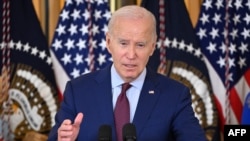When U.S. President Joe Biden visits Vietnam in early September, experts say Washington and Hanoi are likely to upgrade ties to a strategic partnership, an important step for bilateral relations. Experts add, however, that this should not be misinterpreted as Vietnam aligning with the United States.
In Hanoi's diplomatic hierarchy, a strategic partnership is the second tier, only surpassed by the highest-level designation – a comprehensive strategic partnership.
The White House said August 28 that U.S. President Joe Biden would be going to Hanoi September 10, to meet with Communist Party General Secretary Nguyen Phu Trong, who holds the country’s top position, and other leaders on ways to further deepen bilateral cooperation.
While experts said upgraded ties are close to a sure thing if Biden's visit goes as planned, they said that Vietnamese leaders are upgrading their partnerships more broadly as a defense to China's growing aggression in the region.
"This is not Vietnam moving into a U.S. orbit. This is Vietnam maintaining its own independent orbit – maintaining its own space from China," said Gregory Poling, director of the Asia Maritime Transparency Initiative at the Center for Strategic and International Studies in Washington.
"That leaves a lot of room for pragmatic cooperation and shared interest but Vietnam is not coming to our side of the playground," he said.
'Web of partnerships'
Vietnam has been busy on the diplomatic front over the past year, seeking to upgrade ties with many in the region.
In December, Vietnam upgraded ties with South Korea to a comprehensive strategic partnership, the highest level in Vietnam's diplomatic hierarchy, also held with China, Russia, and India.
Vietnam is also expected to sign a comprehensive strategic partnership with Australia this year, which was announced after Foreign Affairs Minister Bui Thanh Son and his counterpart, Penny Wong, met in Hanoi on August 22.
Singaporean Prime Minister Lee Hsien Loong also visited Hanoi August 27. There, he met with Prime Minister Pham Minh Chinh and the two discussed embarking on a comprehensive strategic partnership.
These enhanced ties are a concerted effort by Hanoi to create a bulwark against Beijing, said Alexander Vuving, a professor at the Asia Pacific Center for Security Studies in Honolulu.
Vietnam "has to upgrade their relationship with all these countries that can help them in case of crisis or even help them to boost their resilience against Chinese encroachment," Vuving said. "If you look at that kind of web of partnerships with all the significant powers in the region, you can be a little more secure. That's the overall strategy for Vietnam. Reaching out – geopolitical promiscuity."
Threats to Vietnam's territorial sovereignty often play out in the South China Sea, known in Vietnam as the East Sea. Vietnam’s exclusive economic zone extends 200 nautical miles off the coastline. China claims nearly all of the resource-rich waters with its nine-dash line – a disputed map demarcation encompassing most of the South China Sea.
China "has coast guard ships and militia ships harassing and disrupting Vietnam's exploration for oil every day," Vuving said. "They are pushing the Vietnamese fishermen out of their own EEZ."
This ceaseless badgering of Vietnamese operations at sea is a top rationale for upgraded ties with the United States and other partners, said Ray Powell, who leads Stanford University's Project Myoushu on the South China Sea.
"The constant pressure that China puts on [Vietnam] from all kinds of angles factors into their desire to keep raising the levels of those partnerships," Powell said. "In a lot of ways it is more about balancing against China than it is about aligning with the United States."
Balancing act
This year marks 10 years since Washington and Hanoi launched a comprehensive partnership. Although experts say the Biden administration is keen to jump two levels to a comprehensive strategic partnership, Vietnamese leaders must be cautious about not angering Beijing even while trying to counter its growing power.
Hanoi and Washington normalized bilateral relations in 1995, and elevated to a comprehensive partnership in 2013. The partnership is a formal designation in Vietnamese foreign policy which puts the U.S. currently in the third tier among Vietnam's diplomatic partners.
Nguyen Khac Giang, visiting fellow at the ISEAS-Yusof Ishak Institute, said moving one step up to a strategic partnership is the likely outcome of Biden's visit as Hanoi treads carefully in order to keep peace with Beijing. "Vietnam is quite careful at balancing that relationship with the two great powers," he said.
Still, the strategic partnership would be an important step for Vietnam to "toughen up" its maritime capabilities, enable potential arms procurement, and send a message to Beijing, he said.
"Very strongly, it would respond to China's pressure that if you push me too far I will have the U.S. [partnership] at least to help protect my own national interest," Giang said.
Editor's note: This story has been updated to correct the date of the White House statement referenced in graph 3.










